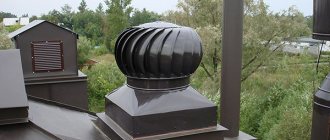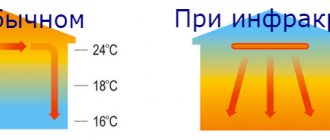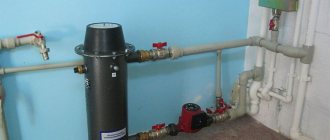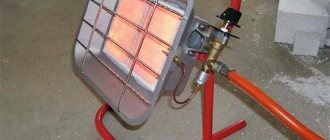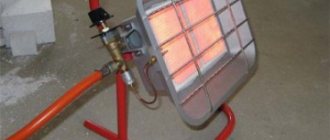Improving a homemade heater
If you plan to use a similar design of an oil heater in another place, for example, in a country house, then some changes will have to be made to it. They will only affect the electrical part. The fact is that you are in the garage temporarily, but in the country house, compared to the garage, you are permanently. Therefore, the requirements for room temperature will be different.
To achieve comfortable heating conditions for a country house, the electrical circuit of the heater must be slightly changed. To do this, a relay is introduced into the heating element circuit, which will control the heating of the element and maintain the specified temperature of the coolant. And again, an old electric iron, or rather its bimetallic plate, can play a positive role. In the iron it served as a regulator of its heating; here its purpose will be the same - to maintain the specified oil temperature. In addition to the direct effect, there will be an additional effect - energy savings. The relationship is direct - the lower the temperature, the less electricity is consumed.
Bimetallic iron plate
A homemade designed oil heater completely replaces a purchased one, and in some respects even surpasses it. This is, firstly, manufacturing to the required dimensions. Secondly, tangible savings in material resources
Of no small importance will be the fact that the garage will be cleared a little of unnecessary rubbish (pipes, cutting corners, profiles), from which a useful and necessary thing will be made
The video shows the making of a slightly different model of oil heater.
Rarely does anyone provide for heating when building a garage. Therefore, during operation, the premises have to be heated independently. Agree, buying heating devices for periodic use is sometimes costly and impractical.
Some craftsmen make the unit themselves, using inexpensive materials. We invite you to familiarize yourself with the three most popular solutions for organizing individual heating.
Before you make a homemade garage heater, you need to understand the operating principle of each unit, its structure and study the assembly procedure.
Heat gas gun
When choosing a homemade heater, you should definitely pay attention to the safety of operation in an enclosed space and comply with certain requirements.
Infrared heaters use ceramic honeycomb burners. During the combustion process, the ceramic elements are heated, and then the heat is transferred to the surrounding air in front of the burner. The heated air then rises and spreads throughout the garage. The power of this type of heaters is up to 6.2 kW, they are much more efficient than electric ones. Disadvantage: substances waste during fuel combustion remain in the garage, so mandatory ventilation is required.
Catalytic gas heaters do not have such disadvantages. The gas combustion process occurs in special honeycombs with a catalyst and almost all combustion products are neutralized. The power of such devices is 3.3 kW.
A gas heat gun is often used to heat a garage Its main drawback is that the emission of burnt fuel and a warm stream of air are not separated, but pass into the room. You can make such a device yourself and in such a way that you don’t suffocate or burn with it. The design can be based on a gas burner with a small canister made in China. First, the gas supply pipe is sawed in the middle, then a suitable section of pipe with a diameter of 80 mm is welded to lengthen it. Next, holes for air with a diameter of 5 mm are drilled and the diameter of the burner nozzle is increased to 2 mm.
Gas gun diagram:
- fan;
- gas-burner;
- burner extension (pipe d 80 mm);
- heat exchanger housing (pipe d 180 mm);
- hot air outlet.
Upgraded version of the gun:
- gas burner extension;
- plates to increase the heat transfer area;
- gas-burner;
- fan;
- air damper with lever;
- heat exchanger housing.
Heating cables
Laying a heated floor in a garage is not always advisable, but in one situation such a design will be more than justified. We are talking about starting a car in cold weather - often a lot of problems are associated with this, and the presence of a heating cable will significantly simplify the task. In addition, you can lay the cable only under the car and turn it on only if you have problems starting the engine.
The machine must first be covered with a cover that will cover it completely - this will allow the thermal energy to be concentrated in one zone. The air will not move into the garage itself, so the level of heat loss will be minimized. This technique will allow you to quickly warm up the car even in severe frost.
Infrared heaters and their features
The operation of infrared heaters is based on the principle of wave radiation, due to which objects and surfaces located in the path of the rays are heated. This is the key difference between infrared devices and other types of heaters, which primarily heat the air.
The main element of the type of heaters under consideration is the emitter. In household devices, the operating temperature of the emitter can reach 600 degrees. In addition to electric IR heaters, there are also gas devices, but using them in rooms without good ventilation (and most garages fit this definition) is prohibited.
There are the following types of infrared emitters:
Metal. Low-temperature heating elements made of stainless steel, equipped with aluminum radiating plates, are the simplest and most reliable elements available. When heating and cooling, such devices crackle slightly.
Ceramic. These emitters consist of a ceramic panel, which is heated by a metal spiral. Such devices are characterized by relatively low efficiency.
Micathermic. The emitter plate of this type is covered with mica and heated to a temperature of 60 degrees. Devices with micathermic emitters are more expensive than the two previous options.
Quartz. The heating element is a tungsten filament, hermetically sealed in a vacuum tube made of quartz glass.
Such devices must be handled with care due to their fragility.
Halogen. Such an emitter is structurally similar to a quartz emitter, but the tube contains an inert gas
The thread heats up to a higher temperature and glows during the heating process.
Carbon. Another representative of tube emitters. The vacuum quartz tube contains a carbon filament, which ensures maximum efficiency compared to halogen and quartz devices. The cost of carbon emitters is the highest compared to analogues.
In garages, IR heaters with aluminum emitters are usually used - they are cheaper, more reliable, and much more durable, which is important when using the device in a garage. Aluminum heaters usually operate at temperatures no higher than 300 degrees
At this temperature, flammable materials (paper and wood) do not ignite, so such heaters meet fire safety requirements. Such devices are also supported by the fact that they do not burn oxygen, and a person can stay in a heated room for a long time without any problems.
Aluminum heaters usually operate at temperatures no higher than 300 degrees. At this temperature, flammable materials (paper and wood) do not ignite, so such heaters meet fire safety requirements. Such devices are also supported by the fact that they do not burn oxygen, and a person can stay in a heated room for a long time without any problems.
When choosing a heater with a plate emitter, you must find out what the thickness of the anode layer is - for normal and long-term operation of the device, this figure must exceed 25 microns. The heating element must be located in a stainless steel housing that will not rust in high humidity in the room.
Infrared heaters for garages have the following number of advantages:
- Possibility of uniform heating of the entire room or creating local heating in a specific area;
- The ability to warm up any area of the garage, including even the most inaccessible ones.
Design and features of convector heaters
Convection is a working principle in which heating occurs due to the different densities of cold and heated air. Cold air from below enters the heater through special holes, heats up, its specific gravity becomes less, and the heated air exits through holes located in the upper part of the device.
In heating convectors, everything happens in strict accordance with this principle - i.e. the air moves naturally, heating up in the inside of the heater. Increasing the intensity of cold air intake significantly increases the heat transfer of the convector.
Typically, convection heaters are installed on walls - this allows the device to draw air from below and release heat through the top panel. The holes in the upper part of the convector are equipped with special elements that allow you to regulate the direction of movement of heated air.
There are several types of convectors:
- Electrical. They are easy to install and operate.
- Gas. The main distinguishing feature of these devices is their high power. When installing gas heaters, you need to provide a high-quality chimney for supplying air and removing combustion products. In small spaces, only devices with a closed combustion chamber can be used.
- Mermen.
Among the advantages of convector heaters it is worth noting:
- Low temperature of the device, which eliminates the possibility of burns upon contact with it;
- Limit degree of fire safety of electrical devices;
- Simplicity of design and minimal likelihood of breakdown.
What is needed to make a heater?
In every garage you can find a lot of useful things that at first glance do not seem to be of much value, but in the hands of a skilled owner they can turn into useful devices or devices. In its design, a homemade heater resembles factory analogs, where the operating principle is based on the fact that the heating element, in this case a nichrome spiral, is hermetically sealed between sheets of fiberglass, as a result of which the sheet heats up and heats the surrounding air.
To make a homemade heater you will need:
Nichrome wire heating element
- Fiberglass.
- Glue Monolith.
- Nichrome wire.
- Electrical wire.
- Metal rivets.
- Electric drill.
- Matches.
Fiberglass will require two sheets, each 50x50 cm in size and no more than 1.5 cm thick. Although the sizes may be different, the sheets must be the same in thickness and geometric dimensions. A garage heater can be square or rectangular in shape, but the perimeter of its sides should not be more than two meters.
Fiberglass parts are necessary to secure the main heating element in our homemade device - a nichrome spiral, which is made from 24 m of wire. Two pieces of electrical wire length, based on the location of the heater and the electrical outlet. Metal rivets can be replaced with bolts and nuts.
For a similar model of a homemade heater, the power of which will be 100 W, nichrome wire is used with a cross-section of no more than 0.3 mm.
Making a tabletop fan heater
This type of device is a heater and fan rolled into one. If desired, a homemade fan heater can be used as an improvised air conditioner.
This type of heater is convenient because it allows you to regulate the heating temperature and the rotation speed of the cooler.
Selection of required materials
To create a fan heater you will need the following materials:
- rheostat;
- switch;
- power connector;
- electrical wire;
- LED Strip Light;
- 12 Volt computer cooler;
- three-amp 12-volt power supply;
To fix the heating element, you will also need two ten-centimeter rods of copper wiring with a cross-section of 1.5 sq. mm.
The tools you need to prepare are:
- jigsaw;
- hammer drill or drill;
- soldering iron;
- hole saw;
- glue for woodworking;
- “moment” or superglue;
To clean wooden workpieces, removing burrs along the edges, you will also need fine-grained sandpaper.
Assembly of body parts
The future heater will have the shape of a cube. The body of the device is assembled from wooden boards 9 mm thick.
- two square blanks measuring 12*12 cm;
- 3 parts measuring 10.2*10.2 cm;
- two rectangular blanks 12*10.2 cm;
- four small rectangles measuring 1*1.5 cm.
To make the legs of the structure, 2 pieces, each 3 cm long, are sawn off from a wooden stick D12 mm.
To simplify your task, make paper patterns, the dimensions of which correspond to the dimensions of the blanks 12x12 cm. Marking the location of the holes is applied directly to the patterns. They are applied to each side and drilled through.
In a workpiece 10.2*10.2 cm, maintaining a distance of 2.5 cm from the edge, make a hole D7 mm. On the second similar workpiece, two similar holes are made, maintaining a distance of 2.5 cm between them. On the third workpiece, 10.2 * 10.2 cm, a through hole of D9 cm is made in the center.
In each of the four rectangular blanks measuring 1 * 1.5 mm, holes D5 mm are made.
On the long side of a rectangle measuring 12*10.2 cm, moving 1.2 cm from the edge, make two holes D12 mm, maintaining a distance of 7 cm between them.
A square blank with a 9 cm drilled hole is installed inside the body. After this, the last rectangular part is attached, closing the body of the structure. At the final stage, the legs are glued.
Installation of heating elements
A spring stretched between two copper rods will act as a heating element. To determine whether the spring is suitable, you need to connect it to a 12-volt power source and take measurements using a multimeter.
So, to create a warm flow, it is enough if the multimeter readings are 2.5 A. With such parameters, about 30 V of heat will be generated with a power supply of 12 W.
The selected spring is soldered to copper rods, the ends of which are fixed to blanks measuring 1x1.5 cm. The assembled structure is glued to the corners of the body. The bare “tails” of the electrical cable are soldered to the ends of the rods. After this, a bar equipped with holes is attached.
Having fixed the cooler inside the case, the same manipulations are performed with the rheostat, switch and power connector.
If all structural elements are connected correctly, then when the rheostat is turned on, a blue light will light up on the LED strip. When the switch is turned on, the LED strip will acquire a red tint, which will create a violet color against the background of the main blue. After this, the heater spring will begin to heat up.
The assembled structure from the outside can only be sanded and treated with wood wax, or varnished in 2-3 layers.
Thanks to its presentable appearance, such a heater can be safely used not only for heating a garage, but also when arranging living rooms.
Alternative options for economical garage heating are described in this article.
Types of IR heaters for garages
You can install an infrared heater in the garage, operating on gas or electricity, of industrial and domestic type, used as general or local heating.
We recommend: Features of heating a greenhouse with an infrared heater
Industrial infrared heaters
The main direction of operation of the equipment is considered to be heating of rooms with ceiling heights from 3 to 8 m. Ideal for heating garages, car services, and car washes. This device operates on electricity, diesel and gas. There are several types of installations:
- light heaters - their name is due to the fact that the bulb, which is responsible for IR radiation, becomes red-hot at the time of heating. The gas combustion temperature is 800-1000 degrees;
- dark heaters - operate at a temperature of 350-400 degrees. They have a minimal radius of the dangerous heating zone, which is very comfortable in a small room. The minimum safe distance for the radiation source is 2.5-3 m. In addition to the listed characteristics, when choosing industrial equipment you need to pay attention to the characteristics of the radiation. For a garage, it is better to choose wall-mounted infrared heaters using long-frequency radiation.
Household heaters
Infrared heating of residential garages is especially popular. The equipment is used for local heating. Often the emitter is mounted above the hood of the vehicle. Even with a sharp decrease in temperature, the engine will not freeze, so it will be easier to start the car. You can use ceiling-mounted devices to heat the garage, as well as mobile models on tripods as a local or general heating system. Some models are specially produced as ceiling panels that are mounted into the cladding.
Stages of assembling a homemade heater
After all materials, tools and accessories are prepared, you can begin assembling a homemade heater:
DIY garage heater
- Fiberglass sheets are cleaned from the inside with fine sandpaper.
- Markings are made - a line is drawn in the upper and lower parts, retreating 2 cm. On the right and left sides of the sheet, the indentation will be 3 cm. The heating coil will be attached to one sheet, for which it is necessary to make several holes on both edges of the sheet. Two more holes must be drilled to secure the electrical supply wires. They are located on the edge where a 3 cm indentation is left.
- Before you make a heater with your own hands, you need to turn the wire into a spiral by winding it around a nail or a long knitting needle.
- Matches, toothpicks or other fastening parts are inserted into the lower and upper holes, which can be easily removed after finishing the work.
- The spiral is laid in rows, starting each row by a match in the hole. A distance of 8-12 mm should be maintained between rows. Every 5-7 cm, the spiral is secured with paper centimeter strips, onto which Monolith glue has been previously applied. When the entire spiral is evenly placed on the panel, the matches can be removed, and these places can be further strengthened with paper strips with glue.
- Metal rivets are inserted into the side holes, onto which the stripped ends of the electrical wire are wound. On the outside of the fiberglass plate, a washer is placed on each rivet so that the contact is firmly fixed.
- The next step will be to check how the assembled electric heater works with your own hands, for which you connect the product to an ohmmeter and a power outlet.
- Now you need to glue the second sheet, for which epoxy-based glue is used. You need 150 grams of it. Epoxy resin is applied between the rows of the spiral and a second panel is placed on top. In order for gluing to occur efficiently, a sheet of plywood is placed on top of the second sheet and loaded. The weight of the load must be 40 kg or more, but not less.
- The time for complete curing of epoxy resin is a day. On the second day, you can already use the homemade device. But before that, you need to make a mount on the back wall if you plan to hang it on the wall or legs if it will be located on the floor.
Water heating
How to make a water-based heater with your own hands using improvised materials? First, metal pipes are welded into batteries of arbitrary shape; they are usually made in the form of a coil. Two will be used to heat the garage, and one more is intended for the inspection pit. Separately from them, a homemade boiler is prepared, in which the heating element will be located, and a magnesium rod is attached to it, protecting the tank from scale.
After preparing all parts of the heating system, they proceed to their installation:
- There are batteries on the walls; they are connected to each other by plastic flexible pipes; instead of fastening, fittings are installed on them.
- A boiler is attached, and a pressure gauge is attached to it to monitor pressure.
- To start the system, water is first poured into it, and then the plugs are opened on the batteries. They are designed to vent air.
- They are debugging the pump and moving it to the desired position. Start the system and check its tightness.
In the next article we will talk in more detail about heating a garage with our own hands.
The above options for creating a garage heater with your own hands can be done at minimal cost. Their design and installation are quite simple even for beginners. If all safety rules are followed, the garage will be warm in any weather.
Here you will learn:
For some people, the garage is a place to store a car, while for others it becomes a means of earning money - client vehicles are repaired here. Sometimes the garage is also its own office; various household tasks are performed here and even small men’s get-togethers are arranged. In this regard, this room needs good heating. Let's see how to organize garage heating with your own hands and what equipment can be used for these purposes.
Heater power calculation
To calculate the thermal power required to warm up the garage, you need to use the following formula:
- N = V x dT x K, where
- N – heater power (kcal/h),
- V – total volume of the room,
- dT – temperature difference between indoors and outdoors,
- K – heat loss coefficient.
For heat loss calculations, the following values of coefficient K are accepted:
- 0.6-0.9 – the garage is well insulated;
- 1-1.9 – garages have average insulation quality;
- 2-2.9 – the garage has insufficient insulation;
- 3-3.9 – the garage is not insulated.
To convert kcal/h to W, a simple formula is used:
- 1 W = 0.86 kcal/h, or
- 1 kcal/h = 1.163 W.
Criteria for choosing a heater
A garage is a non-residential premises used not only for storing vehicles, but also for repairing them. Accordingly, in addition to the four/two-wheeled “friend”, it also stores a considerable amount of all kinds of tools and materials. Most often, it is not possible to provide free access to this room for gas pipes, which means that it can only be heated with the help of heaters powered by electricity.
When thinking about which heater to choose for a garage, it is important, first of all, to determine for yourself the basic criteria that it must meet in its operation:
- compactness is perhaps one of the most important criteria, since there must be enough space to carry out vehicle repairs;
- health safety - despite the fact that the garage is not a residential premises, its owner can often spend a considerable amount of time in it and the type of air he breathes plays an important role;
- ease of operation, installation, etc. - undoubtedly an important criterion, since setting up a heating device is not the purpose for which the garage owner visits it;
- autonomy.
A little later we will look at a wide variety of options for heating devices, but before we begin to familiarize ourselves with them, it is important to determine for ourselves what functions they will perform. This depends, first of all, on the area of the building, the presence of ventilation in it, etc.
Some people note that it is more convenient to work when the room temperature is not very high, and if you are one of those who think so, then a not very powerful compact heater model is quite suitable for you. But first things first.
Catalytic heater: design and operating principle
Today, the climate control equipment market offers a large number of different devices that differ from each other in operating principle and efficiency; some devices are more effective, some are less effective. One of the devices with improved heating properties is a catalytic heater.
Italian model Bartolini Pullover K with a power of 2.9 kW
The catalytic gas heater is used for additional heating of various premises: country cottages, offices, trading floors, cottages, garages, workshops, change houses, etc. But it is not recommended to use this device in buildings where fuels and lubricants are stored.
Design and operating principle
During operation of the catalytic heater, thermal energy is released due to the oxidation of fuel vapor (gas or gasoline) on the surface of the catalyst plate, which is made of fiberglass and coated with a thin layer of platinum powder. The entire surface of the plate is covered with many small holes through which fuel passes and burns on the surface.
This process is often called “surface combustion”, it is safer, more efficient and environmentally friendly compared to “open flame” combustion, despite the fact that the plate temperature can rise to +500°C. During flameless combustion of fuel, an oxidation process occurs, as a result of which thermal energy is released, while fuel consumption is minimal.
This principle of operation makes it possible to almost completely eliminate the appearance of unpleasant odors of combustion products in the heated room.
Important! Despite the low emission of combustion products, a catalytic gas heater must be installed in a ventilated room with two ventilation holes located opposite each other, the diameter of which depends on the power of the heater. The hole size must be at least 25 cm² for every 1,000 W.
The service life of the catalytic plate is 7-8 years; after failure, it can be replaced with a new one in specialized centers.
The design of a gas catalytic heater consists of the following elements:
- The catalyst plate is the main working element of the device. In addition, some models are equipped with a tubular electric heater, which is an additional source of heat;
- Control Panel;
- A metal casing in which a container with fuel is installed. In addition, there are models without a housing; they are more compact and can be used during camping trips to heat a tent or heat a vehicle.
Operating principle of a catalytic heater
The catalytic burner design can also be equipped with:
- A fan that distributes heated air throughout the room more efficiently and evenly;
- A heat fan that allows you to increase the heater power;
- A horizontal position sensor, which automatically turns off the device if it is installed at an angle or has been subjected to a sudden mechanical impact;
- A flame combustion degree sensor that turns off the gas catalytic heater if the flame exceeds the limit value;
- A carbon dioxide level sensor, which also turns off the device if the concentration of carbon dioxide in the room exceeds 1-1.5% (depending on the manufacturer).
Advantages
- A catalytic gas heater consumes oxygen, but this consumption does not exceed the maximum permissible standards.
- Safety and autonomy. Most models are equipped with a sensor for monitoring the presence of gas in the air, which turns off the device if the maximum value is exceeded.
- Mobility.
Large appliances are equipped with 4 wheels, with which even a pregnant girl can move the heater around the room. Before moving the device from place to place, it must be turned off. - Several operating modes. The Bartolini Pullover K catalytic burner (like many other models) has 3 operating modes with different fuel consumption. With this you can use the heating device more efficiently and economically:
- Mode 1 (1200 W) – fuel consumption 100 g/hour;
- Mode 2 (2400 W) – 200 g/hour;
- Mode 3 (2900 W) – 300 g/hour.
Flaws
- High price. The price of the Bartolini Pullover K model with a power of 2.9 kW is 10,500 rubles.
Movement
Run to keep warm
Don't know how to keep warm in the car if the methods described above do not work for you? Remember the main character from the film “The Irony of Fate or Enjoy Your Bath”? That shot of him jumping on the spot and jogging to warm up. In fact, this is the most effective way to warm up, but at the same time the simplest. That is why it ended up on one of the lowest lines of the rating.
We can recommend the following: turn on the music (if your mobile phone has enough charge), put on headphones and beat out the rhythm with almost all parts of the body to a catchy melody.
It is also useful to periodically rub your limbs to prevent them from going numb.
If it doesn’t help, then you need to leave the salon. And quickly run around the car for as long as possible. You need to breathe slowly and evenly. After warming up, you should not stay outside. Get back in the car. If you freeze, go out again.
Thermos seventh place in the ranking
An ordinary thermos, preferably a large one, will help keep you warm inside the car. Or rather, not he himself, but his contents. Hot tea has a good effect on blood circulation and does not constrict blood vessels, such as coffee. It’s best to carry just a thermos with a hot thyme drink. This tea will warm you up very quickly. As is known, the substances contained in this herb growing in the mountains are very beneficial for the human body. Since ancient times, frostbitten travelers were warmed with just such tea, giving it to drink.
To warm up, you can drink a cup of hot tea or coffee
The British would advise drinking a little grog or mulled wine. But in addition to hot water, then you need to take a bottle of semi-sweet wine with you on the road. Ideally, the wine should be boiled, but in road conditions it can simply be mixed with hot water. It will not only help you stay warm in winter, but will also lift your spirits. But it’s better not to get carried away with alcoholic drinks, such as vodka, while sitting in the car. They only provide illusory warmth, but in reality the consequences can be disastrous. “Under alcohol” you can easily fall asleep and freeze.
You can also mix linden honey with hot water, which you can keep in the glove compartment of your car. A spoonful of honey mixed with hot water will warm you better than any other remedy.
Heating with liquid fuel
Do-it-yourself budget heating of a garage can be done using liquid heating units, including homemade ones. In our reviews, we have already described exhaust furnaces that provide cheap, and in some cases, free heat. For example, if you are changing engine oil, then over the spring and summer you can collect several barrels of finished fuel. A properly assembled oil stove will generate a large amount of heat and will delight you with even combustion without soot and soot.
Pyrolysis-type furnaces consisting of several parts, as shown in the figure, give good results. A fire is lit in the oil container, as a result of which oil vapors and pyrolysis products begin to form. They are burned in a vertical pipe with holes, producing a large amount of heat. By regulating the access of oxygen, you can adjust the intensity of combustion.
When using any stove, it is better to allocate a separate corner for it. You also need to think about a reliable foundation and lining the adjacent walls with non-combustible materials.
Using a stove with a plasma bowl to heat your garage, you can achieve maximum heat transfer and minimum fuel consumption. The oil here breaks down into its constituent parts in a hot bowl, after which it burns to form a bluish-white flame, similar to plasma. Of course, there is no trace of plasma here, since it is formed at much higher temperatures. These furnaces are characterized as the most productive.
Solid fuel heating of the garage
The easiest way to organize economical heating of a garage in winter is to use solid fuel equipment. Firewood is quite cheap, burning with it is very easy, simple and relatively safe. And to burn them, you can build any type of stove. If you need to organize homemade heating in the garage as cheaply and quickly as possible, it is best to turn your attention to a potbelly stove type stove. A potbelly stove is the simplest heating unit. Structurally, it consists of two parts - a combustion chamber and a chimney. The ash pan door and the loading door are located at the front. A chimney is diverted from the rear. You can create a potbelly stove for organizing heating in the garage from a variety of materials:
A simple potbelly stove is usually the most commonly used unit for heating a garage, due to its unpretentiousness and low cost of fuel.
- From an old gas cylinder;
- From a steel can;
- From an old barrel;
- Made from sheet iron.
There are dozens and even hundreds of drawing options, so there will be no problems with assembly.
The most economical way to organize autonomous heating in a garage is to use a Buleryan solid fuel stove. This oven is a convection oven, it is characterized by very high performance and can be used to heat any technical premises. Buleryan can be purchased ready-made or assembled yourself. When creating garage heating with your own hands, remember that Buleryans are pyrolytic - this ensures maximum heat transfer and long-lasting combustion.
Making heating in the garage with your own hands is not difficult - all you need is to have at your disposal the appropriate equipment or tools for its manufacture. For example, we can assemble a fireplace-type stove in the garage. Having found the drawings, nothing will prevent you from making a homemade Buleryan or installing a fireplace stove with a water circuit - this option is useful when creating heating in large areas.
If you want to heat your garage as economically as possible, use ready-made factory equipment - solid fuel boilers, including pyrolysis ones, will be waiting for you here. In addition to them, it remains to lay pipes and install radiators, for example, heating registers made of large diameter pipes. Factory equipment for heating systems has a higher efficiency, which will affect efficiency.
Autonomous gas burners
Autonomous gas burner
Third place in the ranking is the best method, but since it involves the use of an autonomous heater, and we need methods of dealing with the cold, so to speak, “with our bare hands,” it ended up in third place.
The choice of autonomous heaters for cars today is quite wide. Among the many models, we can highlight a liquid heater, for example, such as Webasto. Such heaters will not only warm the car interior, but will also help start the car engine, as they are pre-heaters for the fluid. Only they are expensive and this heater needs to be installed correctly on the car.
Now about completely autonomous heaters, among which gas heaters come first. They use infrared radiation burners as the main element. Such a heater will not only warm the interior, but also make it possible to boil tea or heat food. But in addition to the heater, you will also have to carry a liquefied gas cylinder with you. So for a passenger car, a five-liter cylinder will do just fine.
The video shows how an autonomous gas burner works:
One kilowatt is the rated power of such a burner and this is quite enough to keep warm. As for consumption, it is unlikely that more than 80 grams of gas will be consumed per hour. This means that you will be able to provide yourself with warmth for a day or even more. The gas burner itself is very convenient, light and compact. Carrying it will not cause any inconvenience, but in addition to the cylinder, as additional equipment you must not forget to take with you a lighter, a hose and a reducer.
You should light a gas burner away from flammable materials and observe fire safety measures in every possible way. In addition, you will need to periodically ventilate the interior so as not to suffocate in smoke. Experts advise placing the gas heater in a special box in order to completely eliminate contact of the burner with the car. Prometheus gas burners have proven themselves to be quite good.
Gas heating garage
According to all safety regulations, the gas cylinder must be located outside the heated room, ideally in a locked metal box.
Heating a garage without electricity and a stove is more than possible if you use a gas convector for this. This device is a completely autonomous heater that generates heat through direct combustion of gas. The resulting thermal energy is dissipated using a convector, organizing powerful heating. Combustion products are discharged behind the nearest wall using a two-layer chimney. In a similar way, the air required for the operation of the burner is taken.
Heating a garage with a gas convector gives excellent results, because convection allows you to warm up the premises throughout the entire volume, passing the air in it through itself. The only drawback of such heating is the limited height of the ceilings; it should not exceed 3 meters. Otherwise, more efficient equipment should be used.
The garage can be heated using gas infrared heaters. They will help make the garage warm at almost any ambient temperature. But classic models need good ventilation, since combustion products are released directly into the air. The exception is catalytic heaters, which can heat rooms using heat generated through a chemical reaction of fuel decomposition. Such heating is useful not only in winter, but also in spring, when cold snaps and frosts are possible.
Making a heater for the garage
To maintain a comfortable temperature in the garage, it is not difficult to make your own heater using waste oil. At the same time, the problem of its disposal will be solved, which is also a pressing issue for car owners. To assemble it, almost all the elements and spare parts can be found in your own garage.
When making a heater you will need:
- metal pipes;
- heating element (heating element);
- used oil;
- wire with plug.
Structurally, the body can be made in any form convenient for placement in the garage. The photo shows one of the possible circuits of the device.
Diagram of a homemade oil heater
Metal pipes are used of any diameter. It must be taken into account that the thinner they are, the more of them will be needed. The temperature of the room will depend on the area giving off heat. The length of the pipes is also arbitrary, it is desirable that it be maximum, but at the same time ideally harmonize with the dimensions of the wall where it will be installed. The metal from which the pipes are made is not significant. The thickness of the pipe walls can be any.
The heating element is selected by power and voltage. Practice shows that 1.5-5 kW of heater is quite enough for heating. Here it is necessary to take into account that the comfortable temperature of the garage and apartment differ significantly. And such a wide power spread is given based on the size of the heater. The voltage for connecting the heating element is taken as standard - 220 V (we do not consider other parameters here).
Used oil. Most car enthusiasts change the oil in their car engines themselves almost twice a year. Therefore, as a rule, everyone has work off. All that remains is to collect the required quantity and begin making the heater.
What heating methods are there for a garage?
The most economical way to heat a garage is determined by many factors: availability of fuel raw materials, financial capabilities and distance from the main home.
Heating of the engine shelter can be carried out by the following devices:
- mobile equipment: heat guns and fans for heating;
Related article:
Diesel fuel heat gun. The advantage of such equipment is mobility. After all, you can simply move them wherever you need. Read the article on how to choose this device correctly and what you should pay attention to.
- infrared heaters;
Such a device does not release harmful combustion products into the air
- electric boiler is suitable for spacious rooms; stationary heaters.
High-quality heating equipment is important to create a favorable environment in the garage.
Advantages of electric heating in a garage
It is recommended to consider heating your garage with electricity as the most economical option. It has the following advantages:
- ease of installation and availability of electricity;
- a wide selection of devices of various types;
- you can choose a device with suitable power;
- rapid heat transfer.
Convectors are used as heating devices
The disadvantages of such equipment include its high cost. Keep in mind that the quality of heating depends on the uninterrupted operation of the electrical network.
You can use these methods:
- heat guns are an inexpensive option; after heating, air masses in them are distributed under the influence of a fan;
- infrared equipment heats surfaces and all kinds of objects, and they provide heat. Infrared rays will not harm the car's paint;
- the convector warms itself up and distributes the heat around. It heats the space worse than a cannon, but the heat lasts for a long time;
- The most expensive options include inverter split systems. They allow you to save electricity.
Electric heat gun models heat compact rooms quickly enough
Helpful information! Thermal models are recommended for small spaces. Fan heaters and heat guns not only warm up, but also help dry the wheels and bottom of the car.
Water heating
If the garage is built close to the main building, then the most economical option is to heat the garage in connection with the main heating system.
In this case, you do not need to install a boiler, but you will need to extend the pipeline. This option will lead to loads and an increase in the amount of fuel. If a separate boiler is used, then full power can be used if necessary, and in other cases the equipment operates at rated level.
Water heating can be done not only from a boiler, but also from a stove
Note! To avoid defrosting, you should use antifreeze instead of water in the system.
Gas heating
The most effective option is gas. This is a good solution in cases where there is a gas main nearby. To install such a heat source, it is necessary to draw up design documentation and obtain a special permit. Using gas requires compliance with all safety measures. It is prohibited to use a homemade device or connect any equipment.
Gas heating installation option
Using gas, you can create a complete heating system with a boiler and pipes. It is also used for various types of heaters.
When using liquefied gas, the container for its storage must be stored behind metal walls
Helpful information! Alternatively, you can use liquefied gas for convectors, infrared heaters or guns. When using gas burners and heat guns, do not forget to ventilate.
Solid fuel - a budget option
If you have solid fuel, you can even make a homemade heating structure in the garage. In terms of saving characteristics, coal and firewood are superior to other options. Various industrial waste, combustible waste, and plant residues are used as fuel. This option does not depend on energy lines.
There is a huge variety of stoves powered by this type of fuel.
As a heating device, you can make a stove with your own hands from sheet material, a barrel or from fittings. This heating method is more fire hazardous than others. It is necessary to constantly maintain combustion. Some devices are not environmentally friendly.
This is what the oven looks like in cross section
Wood-burning stoves are available in different options. These are potbelly stoves, long-burning devices, brick structures and pyrolysis devices. A potbelly stove is perfect for small spaces, and it also dries the air. Boilers are a safer option. They can work without the constant presence of a person.
Equipment operating during mining
Devices using waste oils are an economical option. They are used not only in garages, but also for heating private auto repair shops. You can see how to make a heater for heating in a garage with your own hands in the video. Metal pipes, all kinds of tanks and gas cylinders are suitable for this. Even on the basis of a stove, you can make a structure with radiators and pipes.
Operating principle of mining equipment
Remember that such structures require good care. They need to be cleaned of soot at least once a week.
Note! To install the stove, a chimney is required, the height of which should be about 4 meters. Its installation is carried out at a certain slope.
Related article:
Do-it-yourself stove: drawings, video. A heating device using waste engine oil is an economical and simple solution to the problem of heating a garage, workshop, greenhouse and even a home. We will look at how to make it yourself in the article.
Method thirteen, well, this is really for extreme sports enthusiasts
If you often find yourself in situations where you have to fight the cold in the car (for example, you are a traveler), then you can take a regular wood stove with you on the road. If you don't believe me, look:
A real oven in the car
So how? Did you believe it? You can stock up on firewood or brushwood for free, for example, if your forced stop occurred in the forest or next to an old and dilapidated building with a lot of boards.
If your car stalls in winter, don’t despair. Armed with any of the heaters listed above and having studied all the tips described, you will not freeze and survive in harsh weather conditions. Even if you find yourself in a car at night, face to face with a cold and harsh winter, you can create all the conditions in the cabin that are similar to the comfort of home. So, don't worry, motorists!
The best prices and conditions for the purchase of new cars
It has long been known that a comfortable temperature for a driver is the range from +21...23 degrees Celsius. Low temperatures negatively affect concentration and alertness while driving, causing irritability. And safety is affected by driving with limited visibility due to icy windows.
If you have at least once had to get to your car in a parking lot in severe frosts or simply get into an icy car interior after leaving a warm home, then you know firsthand that this feeling is not a pleasant one. And how I would like to warm up at this moment. You can, of course, run around the car or leave the snow while the interior warms up, but there are also less radical methods. As always, there is a solution, and it has long been known among motorists - an autonomous interior heater, which will happily provide comfort.
Gas heater
This group of equipment operates on liquefied gas. Due to its combustion, a special fan is activated. The latter ensures natural air circulation processes in the cabin. The air is heated to certain temperatures. To make this process faster, many devices have additional fans.
These devices can operate even if the engine is turned off. The device also does not require electrical energy, which cannot be said about a standard stove. So, even if you need to stand in one place for a long time, the battery will not run out, and the driver will not freeze.
Among the disadvantages is the ability to heat only the interior. On what car can such an autonomous interior heater be installed?
Working with pipes
After the oil heater circuit has been selected, it is necessary to manufacture its body. We make a drawing, determine the dimensions and start working with an angle grinder. The pipes are cut to length in the required quantity. After cleaning the ends, they are carefully and thoroughly welded. The performance of the heater as a whole will depend on the quality of welding. A leaking seam is not only a nuisance, but also a possible cause of fire. When welding the ends of the pipes, leave one (on the lowest pipe) free. Subsequently, a heating element will be inserted into it. This means that the stub will be of a different configuration.
The finished pipes are tied together. The piping is done with pipes, only of a smaller diameter. On the topmost pipe it is necessary to provide a place where the filler plug will be located. Structurally, it can be made in the form of a welded short pipe with a coupling, one side of which will be welded. Using your plumbing and mechanical experience, the heater configuration can be made more aesthetically pleasing, unlike the one in the photo. By the way, the body can be not only tubular. Radiators from cars, old cast-iron radiators and other closed containers are well suited for this purpose.
Design features of boilers
Turbocharged
A turbocharged gas boiler is distinguished by the presence of a coaxial chimney. This chimney is a pipe-in-pipe design. Through a pipe of a larger diameter, gas combustion products are discharged to the street; through a pipe of a smaller diameter, combustion air enters, which is heated by the exhaust gases, which contributes to efficiency.
Turbocharged boilers are equipped with a forced draft fan, which supplies air to the combustion unit. Such boilers have a closed combustion chamber, which is usually made of copper or copper alloys, sometimes it is cast iron.
Bottled gas, propane, liquefied gas
When converting a boiler to a gas boiler, you can use not only main gas. Your homemade unit can run on liquefied gas or propane. To connect bottled gas, it is necessary to install a reducer, since the gas in the bottle is under high pressure.
In some cases, it is necessary to change the injectors to smaller ones. For convenience, so as not to constantly change cylinders, you can connect several cylinders. Taking into account the fact that on average 2 cylinders are consumed per week to heat a house of about 100 sq.m. and obtain hot water, you can calculate the number of connected gas containers.
For convenience and more efficient use of gas, the cylinders are connected into a so-called ramp; up to 10 cylinders can be connected. The ramp consists of a two-arm collector, which divides the entire group of tanks into 2 parts. After the main group runs out of gas, it switches to the additional group.
Electric garage heating
The easiest way to heat a garage with electricity is to use a suitable heater, either purchased or homemade. If you don’t have the money to buy factory equipment, you can make it yourself. The simplest heating device is a goat heater, the most affordable, but also the most ineffective. It is done easily and simply - take some kind of non-flammable dielectric, and wrap a nichrome wire around it. Next, connect the electrical cable to the product and plug it into the outlet.
Among all the options for heating a garage, this option is considered the most dangerous - electricity is generally not a joke. Bare nichrome wire is used here, there is no insulation of any kind. Users may be burned or receive electric shock, and there is a risk of fire. It is prohibited to leave such heating unattended. And in general, you should not use such makeshift and extremely dangerous heaters.
Electric heating of the garage can be organized using factory heating devices:
Before you start choosing the type of heating, you should take care of at least minimal thermal insulation of the garage. Otherwise, the heat will simply go outside.
- Heat guns - they are extremely safe and provide quick heat injection into the garage. It only takes a few minutes to warm up the entire volume, after which the room will become warm. Minus – increased noise level;
- Infrared heaters are a modern solution that pleases with high efficiency. Infrared heating of the garage does not dry out the air and is not harmful to health. Simple IR heaters are used here, which heat not the air itself, but the surrounding objects, as a result of which they begin to emit heat;
- Electric convectors are a great way to heat a garage in winter and not have to worry about installing or manufacturing complex equipment;
- Electric boilers - in this case, classic water heating using an electric boiler is organized in the garage. A boiler for a garage is selected according to its area and heat losses, focusing on the formula 1 kW of heat per 10 sq. m. area.
Heating of the garage can also be organized using a homemade boiler - for this you will need an electric heating element of suitable power, which must be built into a metal pipe of one diameter or another. Next, bends are welded to the pipe, to which a water heating system with batteries is connected. By the way, these same batteries (heating registers) can be made independently using pipes with a diameter of 100 mm.
Is it possible to heat a garage using IR?
Heating a garage with an infrared heater, wall-mounted or mobile, is not only a rational, but also a profitable solution. The use of IR rays for heating is a distinctive feature of the device. As a result, it is not the air in the room that heats up, but the surface of objects that are close to the installation. A person feels warmth immediately after turning on the device. Using IR emitters, you can warm up both small and spacious rooms.
An infrared gas heater for constant heating of a garage is designed for premises used as automobile workshops. The power of the gas installation is sufficient to obtain the optimal temperature. If you install a programmable thermostat, you can simplify the work process using an automation system and reduce costs by 40%. If you do not need to heat the garage itself, then you can choose spot, local heating with a power of 1 kW.
The main feature is that the emitter closely matches the natural heat coefficient, and the high efficiency can be explained by the fact that there are no heat losses that are observed in other types of heating devices and are spent on heating the air space and heating the pipes. The IR operation process is carried out by gradually heating the environment with secondary heat, which is obtained from the heated surface.
Infrared heater in the garage
Classic electric heaters
This is a fairly broad area, since there are a lot of heaters that run on electricity. Everyone knows what an electric heater is, since they are the ones we most often use in everyday life. All devices have practically the same operating principle: thanks to electric current, the coil heats up, giving off its heat either to the air or to the coolant (most often oil). It is logical that for heaters of this type to operate, an electrical network is required.
Among the advantages of such devices are:
- Ease of use.
- Mobility and accessibility.
- Good heating level.
- Ability to control temperature.
All you need to do is connect the device to the network and press the button. This is a good choice if you need to use heating occasionally. I would like to note that there are such types of devices that you can buy:
- radiators running on oil;
- heat guns;
- wall convectors;
- fans and thermal curtains.
Each of them has its own positive and negative sides. It is not profitable to use such devices to regularly heat a garage. Such heaters cannot be called energy-saving. Their use is rational for short-term use
When choosing equipment, pay attention to the degree of fire safety of the device and its power. Remember, most often garage fires occur precisely because of a breakdown of the electric heater
